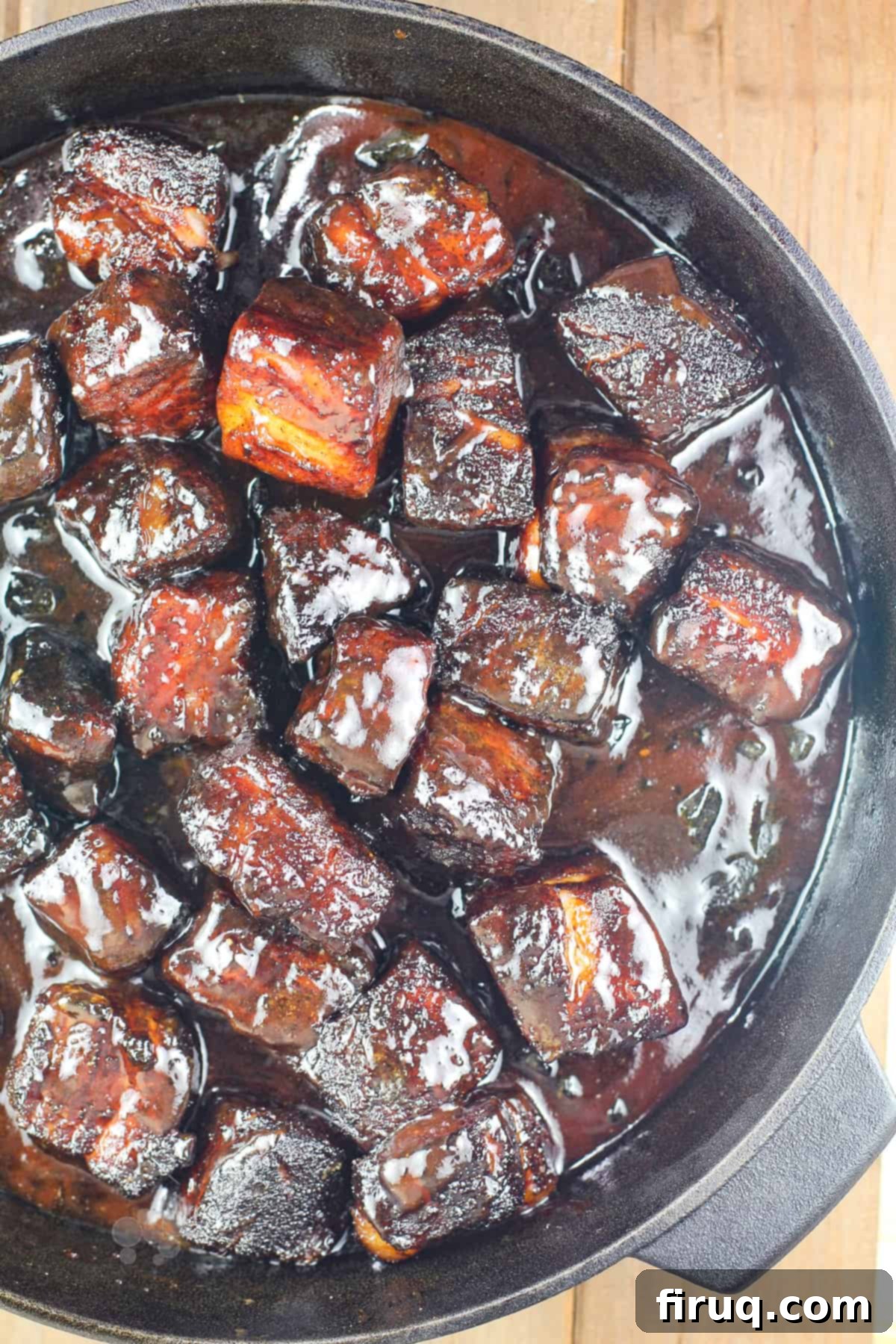Smoked Pork Belly Burnt Ends: The Ultimate Guide to Irresistibly Tender “Meat Candy”
Prepare yourself for an extraordinary culinary experience with Pork Belly Burnt Ends – those irresistible, salty-sweet, and utterly succulent bites of pork belly. Cooked to divine perfection and melt-in-your-mouth tenderness in your Big Green Egg or electric smoker, these morsels are truly barbecue gold. The magic lies in the slow smoking process, which gently renders the rich fat, transforming ordinary pork belly into incredibly flavorful, caramelized chunks that are often dubbed “meat candy.” Get ready to impress your taste buds and everyone lucky enough to share this feast.
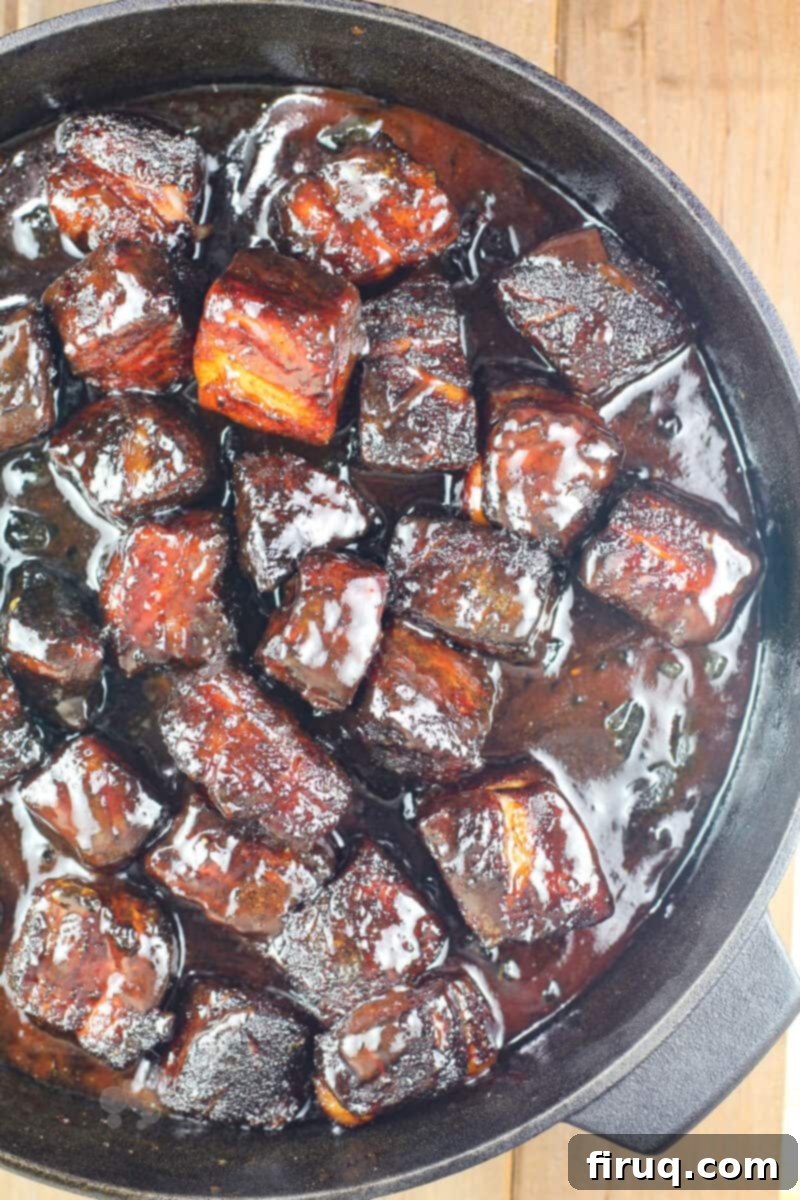
Unveiling the Delicacy: What Are Pork Belly Burnt Ends?
So, what exactly is this remarkable meat that inspires such effusive praise? Think of it as the raw, unadulterated essence of bacon. Yes, we’re talking about pork belly – a magnificent slab of uncured, uncut bacon. In simpler terms, bacon is derived from pork belly, making pork belly the foundational canvas for some of the most flavorful pork dishes imaginable.
Pork belly is celebrated as a delicacy, revered for its rich fat content and deeply satisfying flavor. When prepared correctly, it offers a perfect balance of crispy exterior and tender, juicy interior. Burnt ends elevate pork belly to an entirely new dimension of deliciousness.
Traditionally, “burnt ends” referred to the intensely flavored, slightly charred, and heavily caramelized pieces cut from the point end of a slow-smoked beef brisket. Brisket, however, is notoriously challenging to cook perfectly, often requiring extensive experience and meticulous attention to detail. Having even lived in Texas, I can attest to the scientific precision and patience required for a truly magnificent brisket.
But here’s the good news: utilizing pork belly for burnt ends allows us to enjoy these ridiculously tender, flavor-packed bites of barbecue with significantly greater ease and in a much shorter timeframe – often just a few hours. This recipe is designed to be accessible and straightforward, promising an incredibly rewarding culinary experience that is absolutely worth every moment of effort. It’s the perfect entry point into the world of smoked meats, yielding results that taste like they came from a seasoned pitmaster.
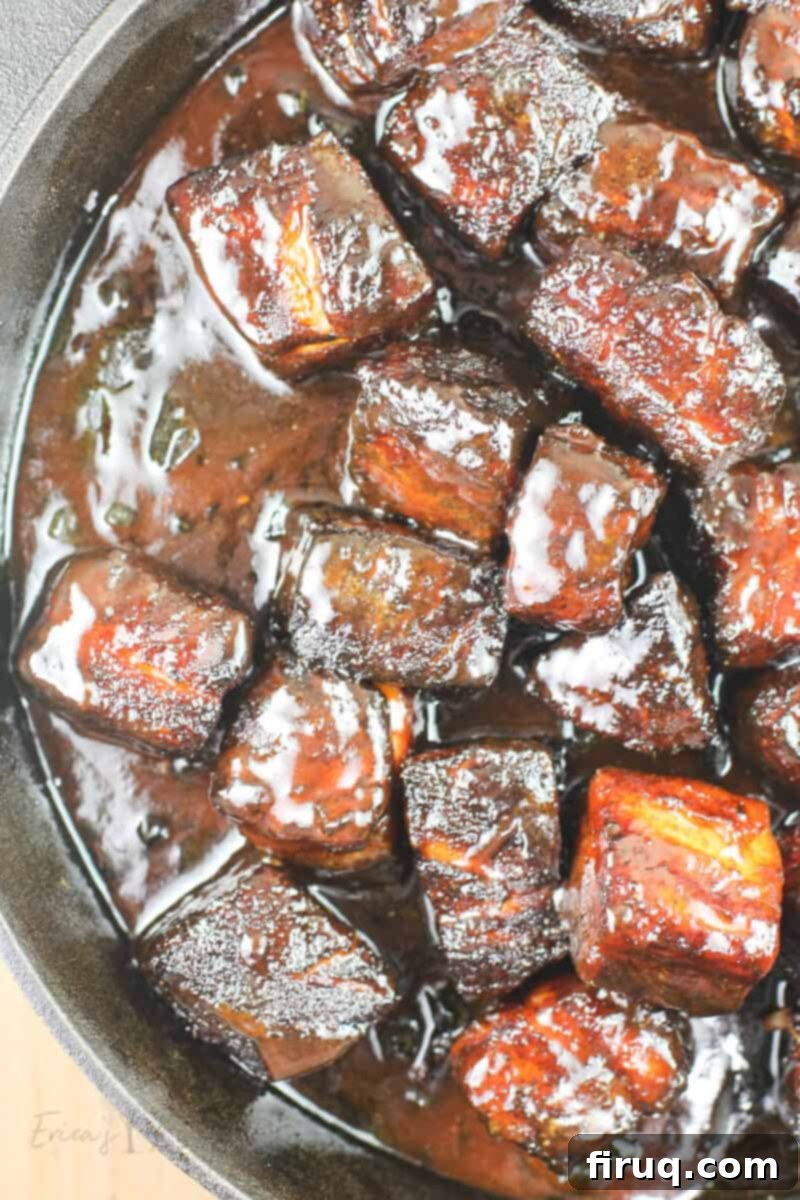
Essential Ingredients for Your Pork Belly Burnt Ends Adventure
Crafting these delectable pork belly burnt ends requires a selection of simple yet powerful ingredients that work together to create an explosion of flavor. You’ll be surprised at how basic these components are, considering the gourmet result they produce!
Ingredients for the Main Event: The Pork Belly
- Pork Belly: The star of our show! Look for a slab of skin-on or skin-off pork belly, ideally 6-7 pounds for a good batch. Most grocery stores and local butcher shops, especially those specializing in barbecue, will carry quality pork belly. If buying with skin on, ensure you have a sharp knife for removal, or ask your butcher to do it for you.
- Dry Rub: This is where a significant amount of the initial flavor comes from. You can use your favorite store-bought barbecue rub or experiment with our recommended pork grilling rub recipe. A good rub typically contains a blend of salt, sugar (brown sugar is common), paprika, garlic powder, onion powder, and a hint of spice. Don’t be shy with it!
- Unsalted Butter: Cubed into small pieces, butter adds richness and helps create that incredible “butter bath” during the second cooking stage, ensuring maximum tenderness and flavor infusion.
- Light Brown Sugar: This provides crucial sweetness and aids in the caramelization process, contributing to the signature “burnt ends” crust.
- Honey: Another key component for sweetness and a beautiful, sticky glaze. Honey also helps tenderize the meat and create that desirable “meat candy” texture.
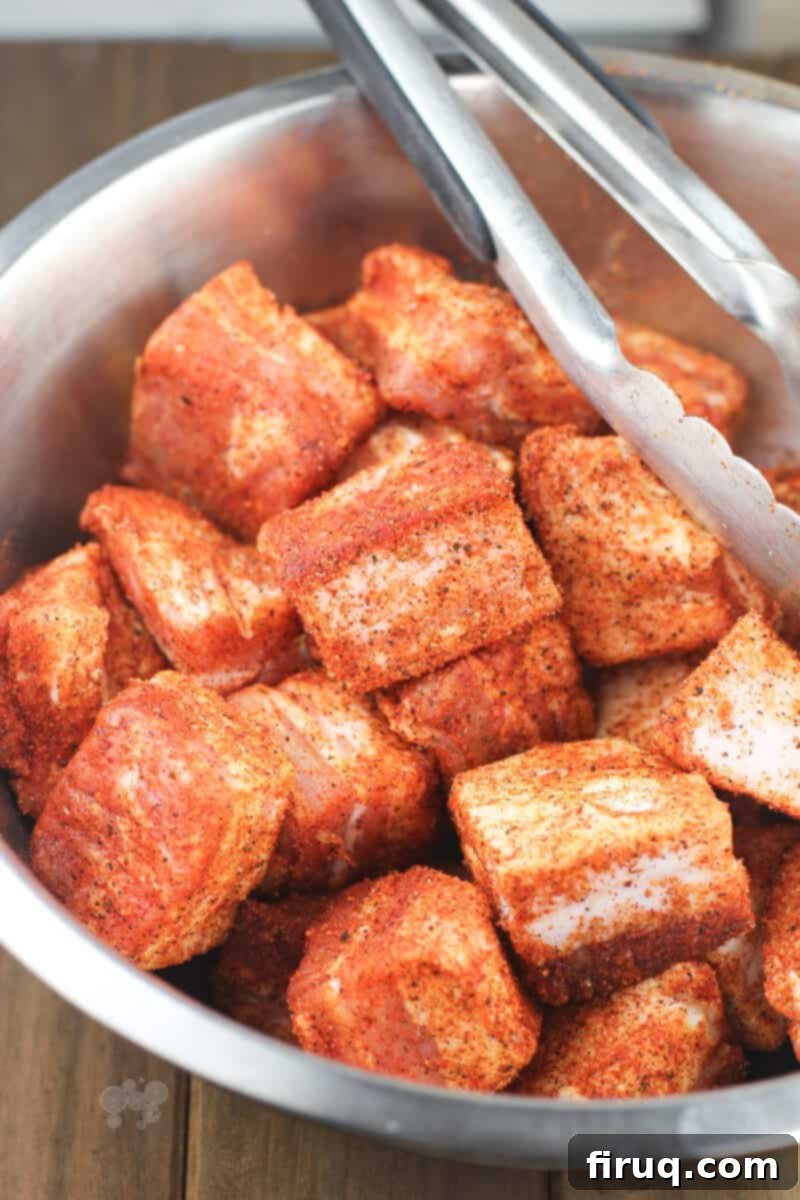
Crafting the Perfect Glaze
The glaze is the final touch, wrapping your pork belly burnt ends in a shimmering, flavorful coating that truly makes them irresistible.
- Barbecue Sauce: Choose a quality barbecue sauce that you love. A sweeter, thicker sauce often works best here. Our Cherry Chipotle Barbecue Sauce recipe is a fantastic choice, offering a unique blend of sweet and smoky with a hint of spice. Feel free to use your personal favorite.
- Apple Juice: This helps thin the glaze slightly, making it easier to coat the pork, and adds a subtle fruity sweetness that complements the pork beautifully.
- Apricot Preserves: A secret weapon for an incredible glaze! Apricot preserves add a vibrant fruity note and a sticky, jam-like consistency that caramelizes wonderfully. If you don’t have apricot, other fruit preserves like peach or cherry can also work well.
- More Honey: A final touch of honey in the glaze amplifies the sweetness and stickiness, ensuring a truly decadent finish.
See? Pretty straightforward ingredients, right? The beauty of this recipe is its versatility. You can elevate your game by making your dry rub and barbecue sauce from scratch for a truly personalized flavor profile, or you can keep it simple and convenient by using store-bought options. Either way, you’re guaranteed to produce deliciously yummy pork belly burnt ends that will be the highlight of any meal or gathering.
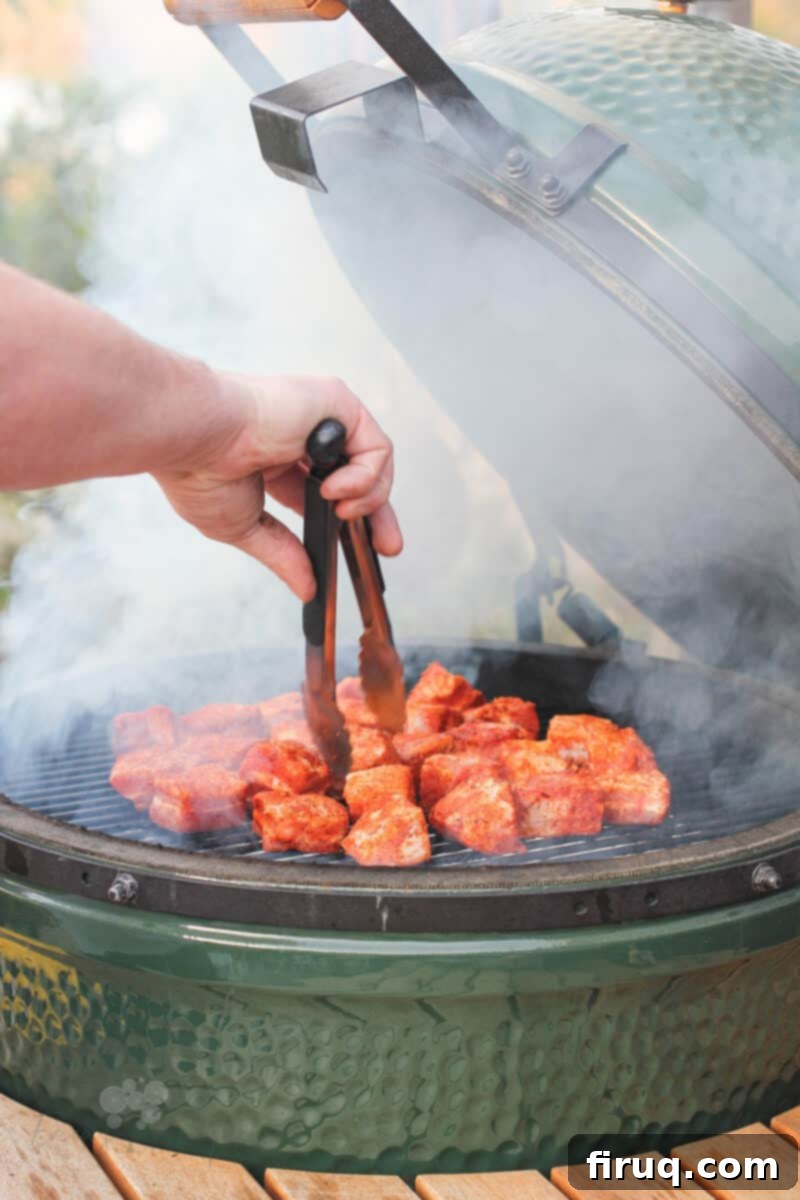
More Big Green Egg and Smoker Recipes to Explore
If you love the magic that happens inside your Big Green Egg or electric smoker, you’re in for a treat! Mastering the art of low and slow cooking opens up a world of incredible flavors and textures. Once you’ve perfected these pork belly burnt ends, you might be looking for your next smoking adventure. Here are some other fantastic recipes that truly shine when cooked in a smoker, promising equally delicious results.
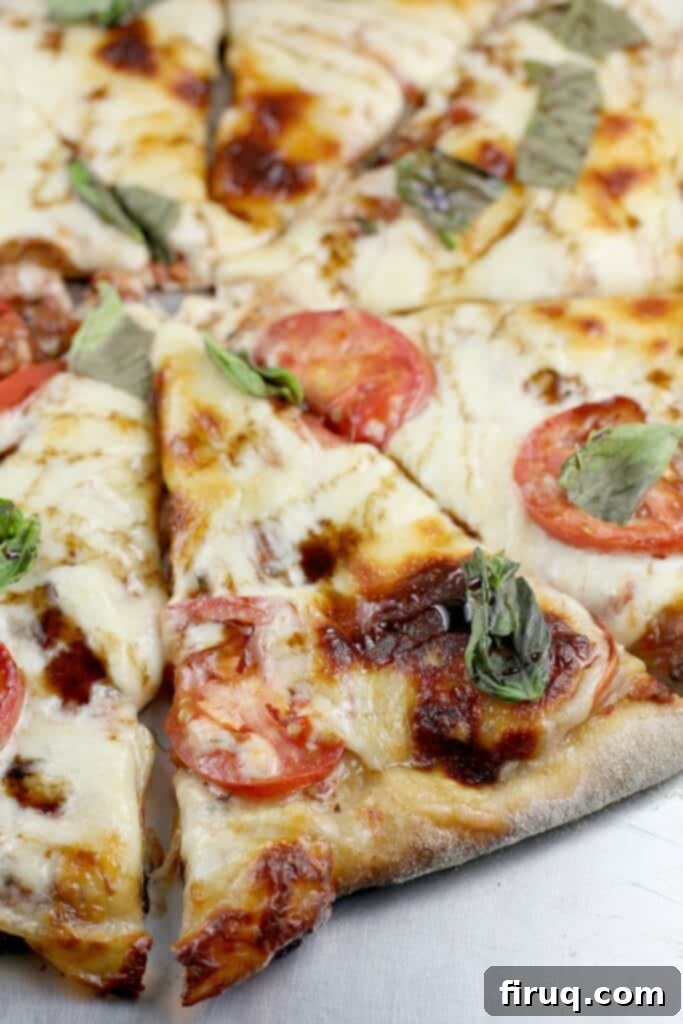
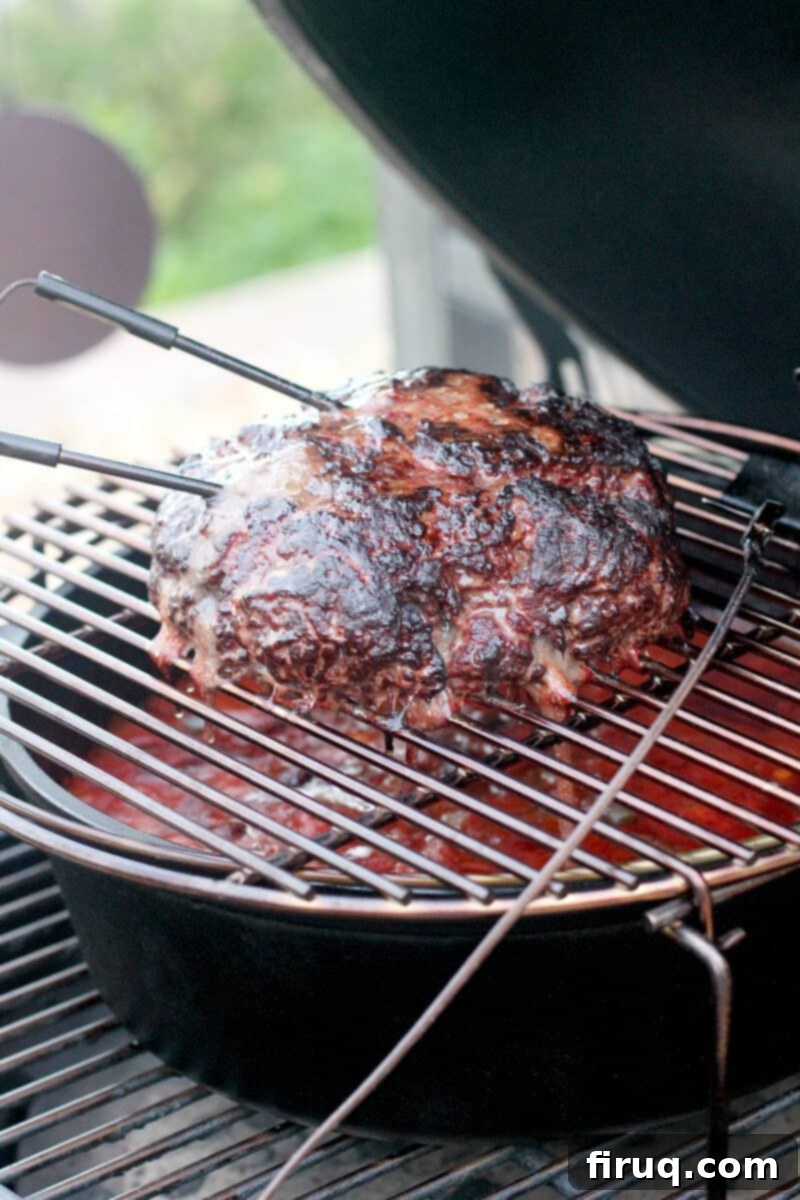

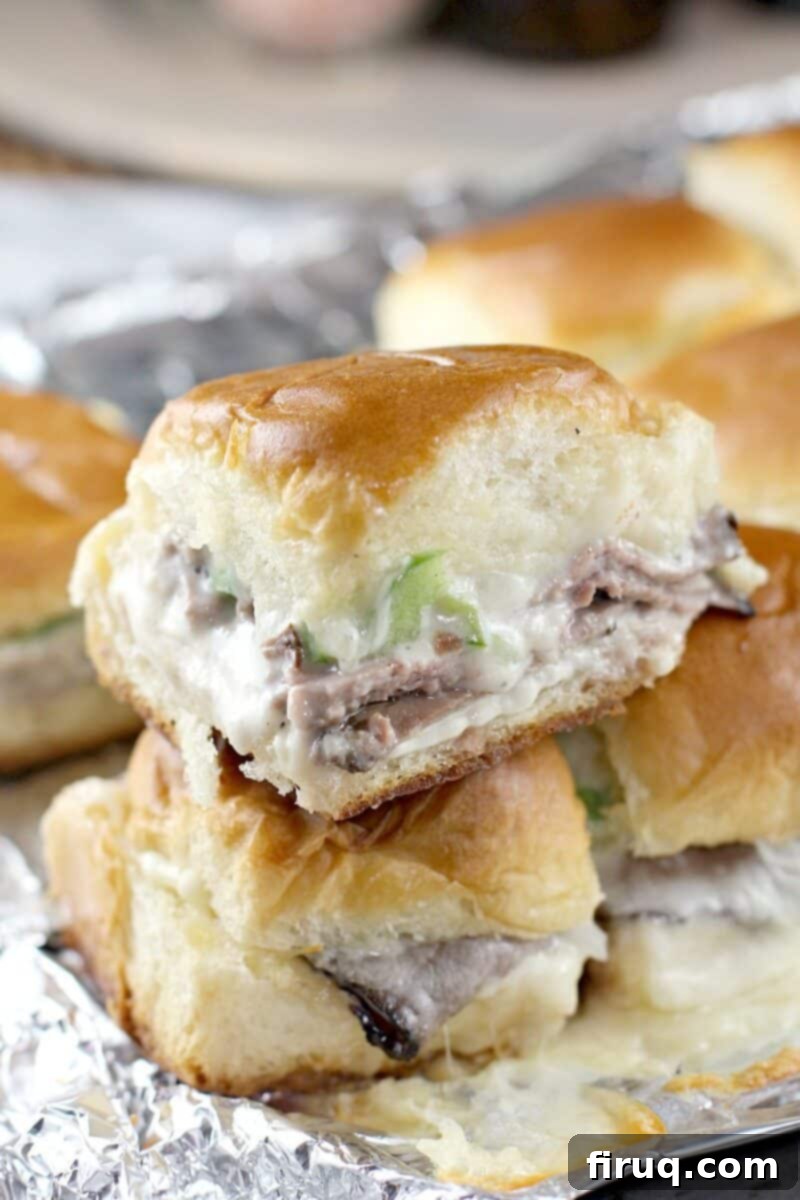
Mastering the Art: How to Cook Perfect Pork Belly Burnt Ends
Achieving those coveted, perfect pork belly burnt ends involves a methodical approach, broken down into three distinct stages. Each stage plays a crucial role in building layers of flavor and achieving that ultimate tender, sticky texture. Patience is key, but the rewards are truly immense.
Stage 1: The Initial Smoke – Infusing Flavor
Before any smoking begins, proper preparation of the pork belly is essential. The first, and sometimes trickiest, step is removing the skin from the pork belly slab. While this can be a bit of a challenge, it’s typically quick, taking only a couple of minutes with the right tools. Use a very sharp, straight-blade knife, working carefully to separate the skin from the fat layer. If you’re uncomfortable doing this, don’t hesitate to ask your butcher to remove the skin when you purchase the pork belly – they are usually happy to oblige. Removing the skin allows the rub to penetrate deeper and prevents a rubbery texture.
Once the skin is removed, cut the pork belly into uniform 1.5 to 2-inch cubes. Uniformity is important for even cooking. Toss these cubes generously with your chosen dry rub, ensuring every piece is thoroughly coated. Don’t be shy with the rub; it forms the foundational flavor and a delicious crust.
Now, it’s time to get the smoker ready. If you’re using an electric smoker, it’s typically designed for indirect heat by default. For a Big Green Egg, you’ll need to set it up for indirect cooking by placing the plate-setter (also known as a convEGGtor) under the grill grate, with its legs facing upwards. This creates a barrier between the direct heat source and the food, allowing for slow, even cooking. Preheat your smoker to a consistent 250°F (120°C).
Next, add your preferred smoking wood – cherry or apple wood are excellent choices for pork, offering a mild, fruity smoke flavor that complements the richness of the belly. Follow your smoker’s manufacturer instructions for adding the wood. Finally, arrange the seasoned pork belly cubes directly on the grill grate, leaving a little space between each piece for optimal smoke circulation. Smoke for approximately 2 hours. During this stage, the pork will begin to absorb that beautiful smoky flavor, and the fat will start to slowly render.
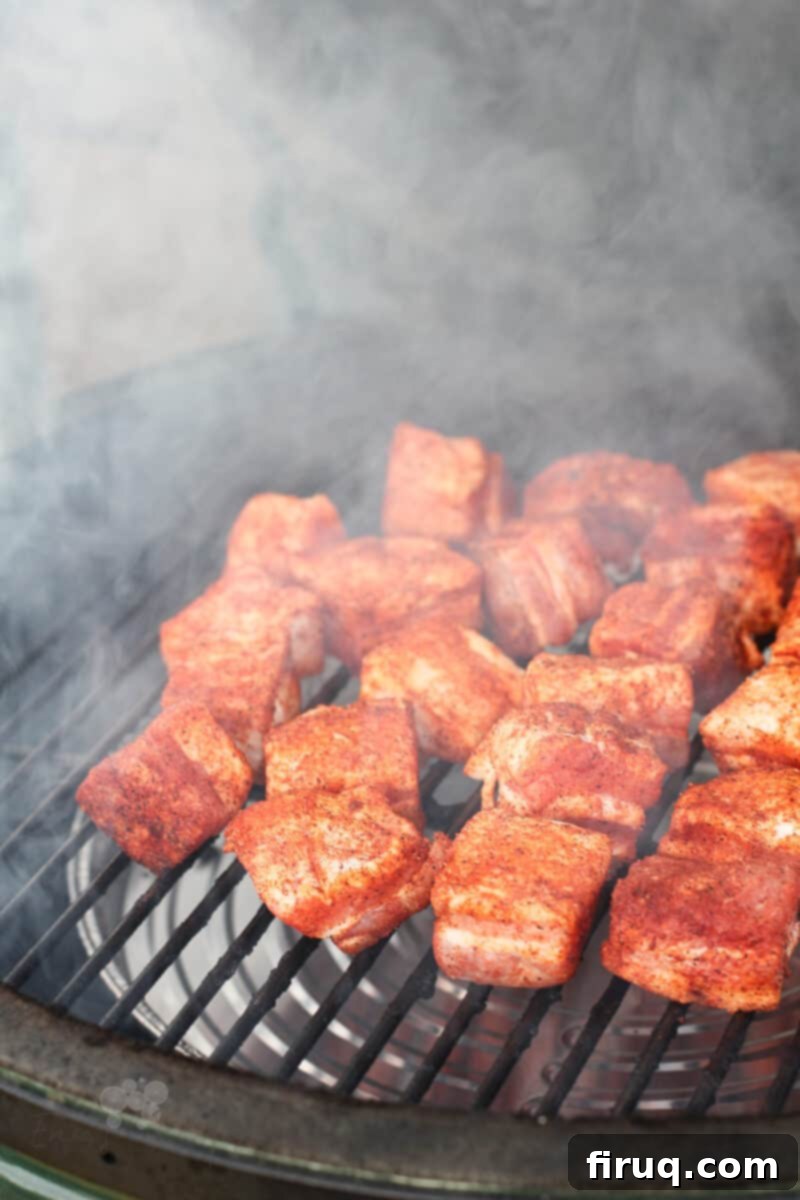
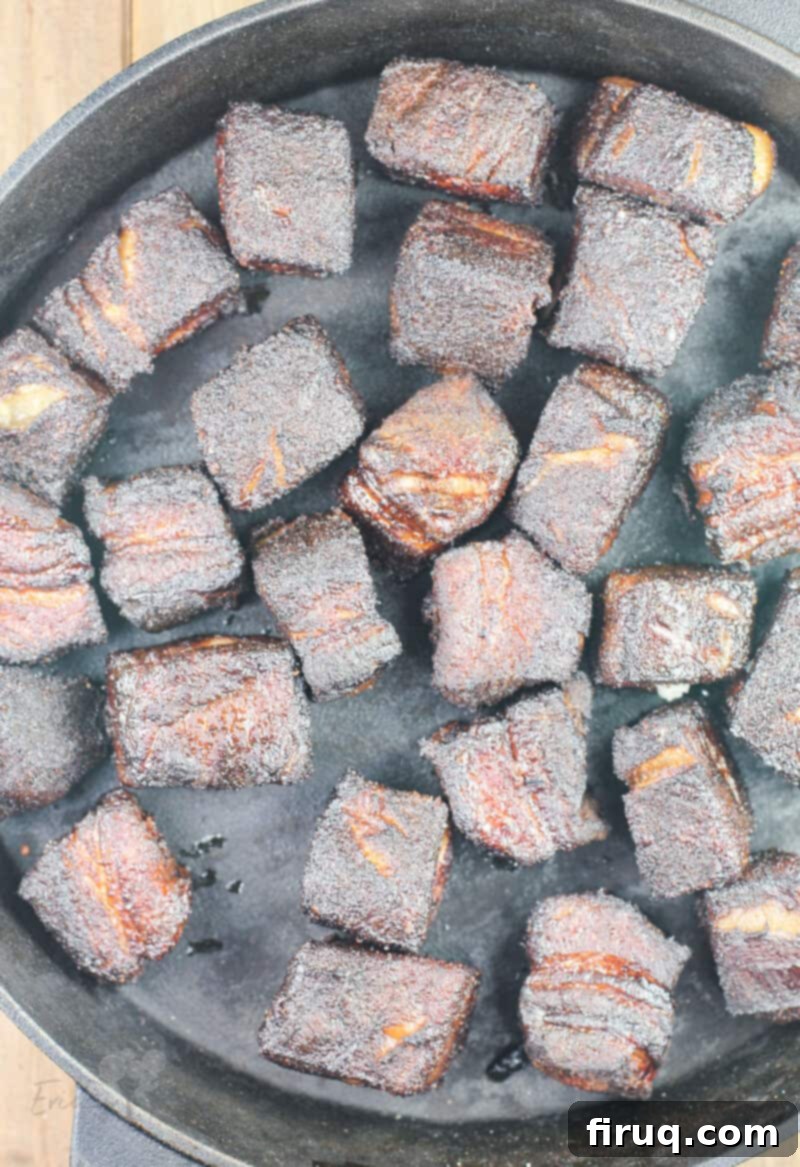
Stage 2: The Butter Bath – Deepening Flavor and Tenderness
After the initial two hours of smoking, carefully transfer the smoky pork belly cubes from the grill grate into a sturdy, grill-proof pan. An aluminum foil pan, a cast iron skillet, or any other heat-safe pan suitable for your smoker will work. This pan will become our “butter bath” chamber.
Generously sprinkle the light brown sugar and cubed unsalted butter over the pork belly. Then, drizzle a good amount of honey over everything. These ingredients are essential; as they melt and combine with the rendered pork fat, they create a rich, sweet, and savory liquid that bathes the pork. This liquid is the precursor to that incredible glaze and helps tenderize the meat even further, infusing it with unparalleled flavor.
Cover the pan tightly with aluminum foil. This creates a steaming effect within the pan, ensuring the pork belly continues to cook gently and becomes incredibly tender while preventing it from drying out. Return the covered pan to the smoker and continue cooking for an additional 1.5 hours, or until the pork cubes are exceptionally tender. You should be able to easily pull them apart with tongs. During this stage, the magic truly happens: the butter, honey, and brown sugar work together to create a nascent glaze, transforming the pork into those sought-after “burnt ends.”
Stage 3: The Grand Finale – Setting the Irresistible Glaze
As your pork belly is reaching peak tenderness in the butter bath, it’s time to prepare the finishing glaze. In a small saucepan, combine your barbecue sauce, apple juice, apricot preserves, and an additional tablespoon of honey. Heat this mixture over medium heat, stirring occasionally, until it’s warm and completely smooth. The preserves should dissolve and integrate seamlessly into the sauce, creating a luscious, shiny glaze.
Once the pork is tender, carefully remove the pan from the smoker. Drain any excess liquid from the pan, leaving just the succulent pork belly cubes. Pour the prepared glaze over the pork and gently toss to ensure every single piece is thoroughly coated in that sticky, flavorful goodness. This is where your “meat candy” truly starts to take shape!
Return the uncovered pan to the smoker for a final 5-10 minutes. This short, uncovered cook allows the glaze to caramelize slightly and set beautifully, creating that signature sticky, slightly crispy exterior that defines perfect burnt ends. Keep a close eye on them during this stage to prevent actual burning. Once the glaze is glistening and tacky, your perfect pork belly burnt ends are ready to savor! Serve them warm as an appetizer, a side dish, or even as the star of your barbecue spread. The rich aroma and irresistible taste will have everyone coming back for more.
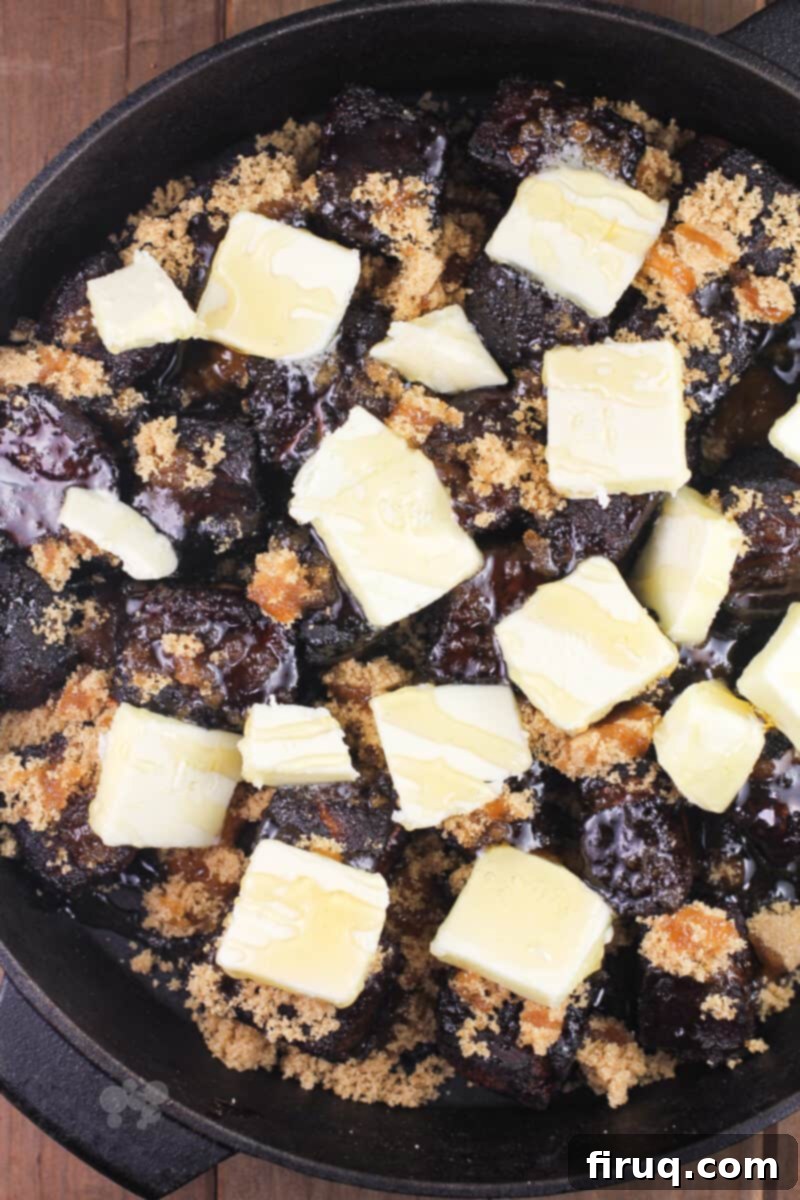
Frequently Asked Questions About Pork Belly Burnt Ends
Yes, absolutely! While a dedicated smoker is ideal for consistent low and slow temperatures and deep smoke flavor, you can certainly adapt this recipe for a charcoal or gas grill. The key is to achieve and maintain indirect heat. For a charcoal grill, bank your coals to one side and cook the pork on the other. For a gas grill, only light burners on one side and place the pork on the unlit side. You’ll also need to introduce smoke; for charcoal, add wood chunks directly to the coals, and for gas, use a smoke box filled with wood chips placed over a lit burner. Remember, the goal is slow cooking, not direct searing, even though they’re called “burnt ends,” they are not actually charred black.
Yes, you can! While your pork belly won’t develop that signature, rich smoky flavor that comes from a smoker, it will still be incredibly delicious. Pork belly is inherently flavorful and rich in fat, so even when oven-roasted, it will be ridiculously tender and tasty. Follow the same three-stage process, simply using your oven set to 250°F (120°C) instead of a smoker. You’ll still achieve that wonderfully tender texture and sticky, caramelized glaze.
Absolutely! Pork belly burnt ends are an excellent make-ahead dish, making them perfect for parties, potlucks, or meal prepping. You can cook them fully, allow them to cool, and then store them in an airtight container in the refrigerator for up to 3-4 days. To reheat, simply place them back in a pan, cover with foil, and warm gently in an oven or smoker set to 250-300°F (120-150°C) until heated through. You might want to add a splash of apple juice or a little extra BBQ sauce to keep them moist.
Certainly! Apricot preserves offer a wonderful flavor, but feel free to experiment with other fruit-based jams or jellies to customize your glaze. Apple jelly, peach preserves, or cherry jelly are all excellent and appropriate substitutes that will complement the pork beautifully, adding their own unique sweet and fruity notes to the final glaze.
Unfortunately, when it comes to pork belly burnt ends, quality truly comes from patience. The “low and slow” cooking method is non-negotiable for rendering the fat properly and achieving that incredibly tender, melt-in-your-mouth texture. Trying to rush the process by increasing the heat will likely result in tough, dry, or greasy pork, rather than the succulent, caramelized bites we’re aiming for. Embrace the journey; the wait is absolutely worth it!
For true “burnt ends” in the style of this recipe, pork belly is really the only suitable cut. Its unique balance of lean meat and generous fat layers is what allows it to transform into those tender, juicy, and caramelized bites. While you can smoke other cuts of pork, they won’t yield the same “burnt end” experience or texture. If pork belly isn’t available, it might be best to try a different smoked pork recipe altogether rather than a direct substitution.
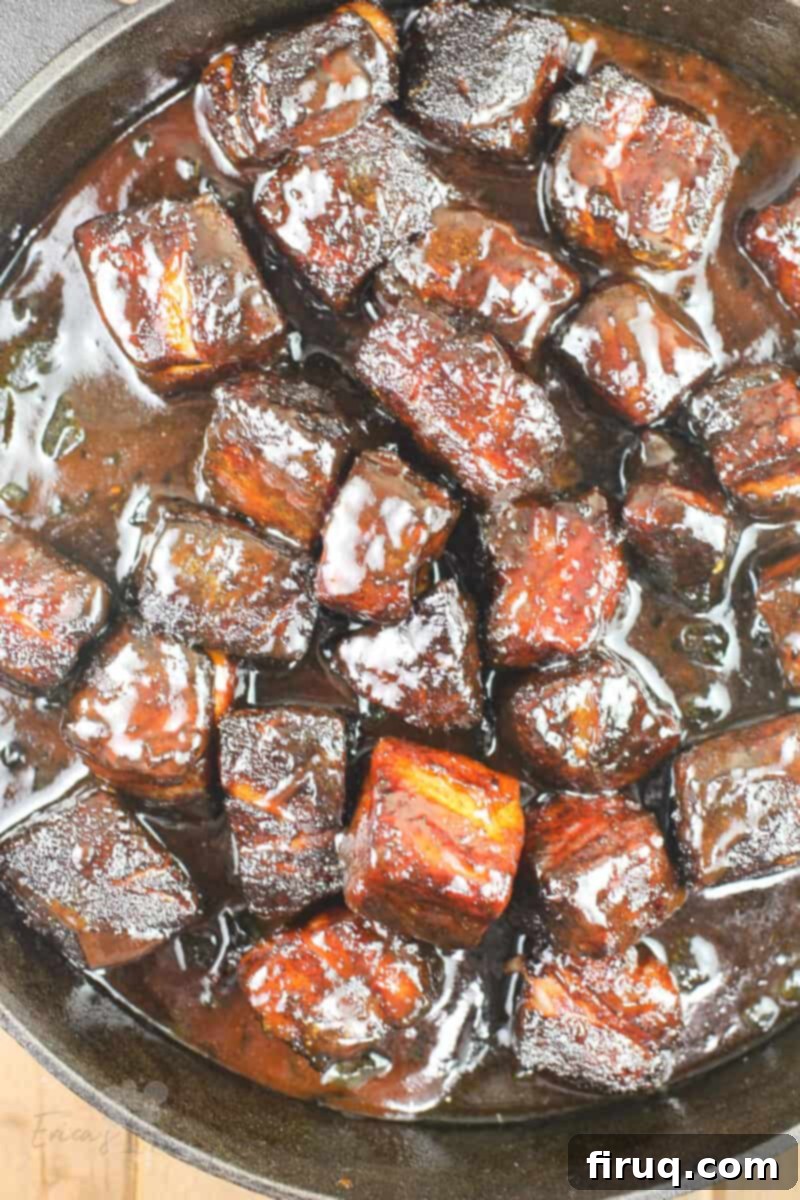
For the ultimate in Big Green Egg cooking, be sure to explore my incredible Smoked Over-The-Top Chili recipe!
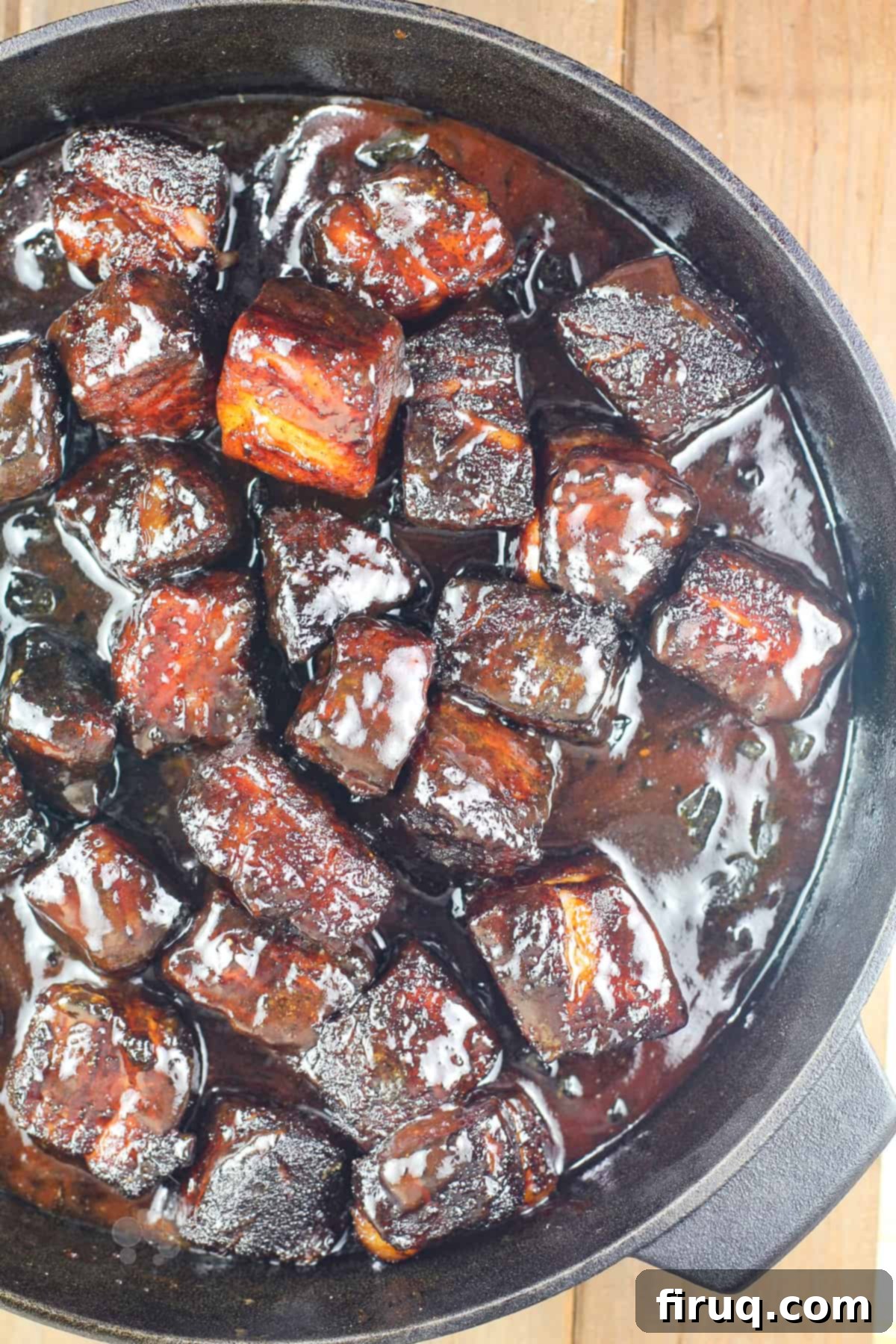
Pork Belly Burnt Ends
Print
Pin
Rate
Ingredients
- Cherry or apple wood for smoking
- 6-7 lb pork belly skin removed and discarded, cut into 1-½ to 2-inch pieces
- ~½ cup barbecue rub of choice
- 2 sticks unsalted butter cubed
- ½ cup light brown sugar
- ¼ cup honey
For the glaze
- 1 cup barbecue sauce of choice
- ¼ cup apple juice
- ¼ cup apricot preserves
- 1 Tbsp honey
Instructions
-
Set up your Big Green Egg (BGE) or electric smoker to maintain a consistent temperature of 250°F (120°C) with indirect heat. For the BGE, ensure the plate-setter (convEGGtor) is placed under the grill grate with legs up.
-
Thoroughly toss the cut pork belly pieces with your chosen barbecue rub, ensuring each cube is evenly coated.
-
Add your preferred smoking wood (cherry or apple work wonderfully) to the BGE or smoker, following the manufacturer’s instructions for your specific unit.
-
Arrange the seasoned pork belly cubes on the grill grate, leaving a small space between them, and smoke for 2 hours.
-
Transfer the pork to a grill-proof pan (such as an aluminum pan or cast iron skillet). Evenly sprinkle the brown sugar and cubed butter over the pork, then drizzle with honey. Cover the pan tightly with foil, return it to the smoker, and cook for an additional 1-½ hours, or until the pork is exceptionally tender.
-
While the pork is finishing, combine all the glaze ingredients (barbecue sauce, apple juice, apricot preserves, and 1 Tbsp honey) in a small saucepan over medium heat. Stir until warm and smooth.
-
Carefully drain any excess juices from the pork pan. Pour the prepared glaze over the pork belly and toss gently to ensure all pieces are well coated. Return the uncovered pan to the smoker for 5-10 minutes to allow the glaze to caramelize and set. Serve immediately and enjoy your delicious “meat candy”!
Notes
I strongly recommend placing a drip pan directly underneath the pork belly on the grate during the first smoking stage. This will catch all the rendered fat and juices, significantly reducing cleanup and preventing flare-ups.
Nutrition
This incredible recipe was adapted from How to BBQ Right, a fantastic resource for barbecue enthusiasts.
